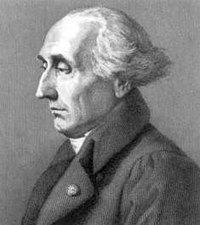
Born in Turin, Italy on January 25, 1736, to Giuseppe Francesco Lodovico Lagrangia and Teresa Grosso, Joseph Louis Lagrange would become a mathematical prodigy in his lifetime. Although Lagrange was the eldest of eleven children, he was only one of two that would survive to adulthood. Growing up, Lagrange attended the College of Turin, pursuing a career as a lawyer planned by his father.
Lagrange’s first mathematic encounter was Greek geometry—a subject he found quite boring. After reading Edmond Halley’s 1693 paper on the use of algebra in optics and being exposed to the excellent physics teaching of Beccaria, Lagrange decided to take up his career in mathematics.
Lagrange’s first publication was put out on July 23, 1754, on the binomial theorem. Lagrange discovered soon after that Bernoulli and Leibniz were already addressing the issue. To avoid being accused of using the work of others, he began studying the tautochrone, “the curve on which a weighted particle will always arrive at a fixed point in the same time independent of its initial position.” After sending the results of his work on August 12, 1755, Euler’s response, sent on September 6, stated how impressed he was with Lagrange’s new ideas on maxima and minima. Thus, Lagrange had made his first splash in the lake of mathematics.
On September 28, Lagrange became the professor of mathematics at the Royal Artillery School in Turin. Soon after, in 1756, Lagrange sent Euler a copy of his work on the “Calculus of Variations”. Euler, who had been working on the subject himself, found that Lagrange’s results were more generalized than his. Once again impressed with the work of this “remarkable young mathematician”, Euler had a position arranged for him that promised to be far more prestigious than the one he held in Turin. Lagrange did not seek fame and saw no reason to come to Prussia while Euler, who he had much respect for, already had the position of director of mathematics at the Berlin Academy.
In 1758, Lagrange helped found and was a major contributor to the scientific society of Turin, which would become the Royal Academy of Science of Turin. A main objective of this society was their journal, the Mélanges de Turin. Lagrange’s work, which included subjects such as the calculus of variations, probabilities, the principle of least action, kinetic energy, and propagation of sound, appears in the first three volumes, published in 1759, ’62, and ’66. In the third volume, his famous Lagrangian function is introduced, and he uses a characteristic value of linear substitution for differential equations for the first time.
In 1764, Lagrange won the prize competition from the Académie des Sciences in Paris on the subject of the libration, or “wobble”, of the moon. After another offer for a position at the Berlin Academy, Lagrange discovered that Euler would be moving to St. Petersburg. He finally accepted the offer and succeeded Euler as the Director of Mathematics on November 6, 1766. Lagrange continued work in Berlin for 20 years, where he completed many of his important publications. In 1770, he introduced Réflexions sur la résolution algébrique des equations, in which he showed why equations of up to degree four could be solved with radicals.
Lagrange probably made his greatest contributions in working on the subject of the mechanics of the universe. Writing to Laplace in 1782, he described his progress on a comprehensive publication on mechanics. However, the death of his wife and of Frederick II, his patron at the Academy, created a less-than-desirable situation to remain in Berlin. Offers were made from many cities to obtain this valuable mathematician. He accepted an offer from Paris at the Académie des Sciences and left Berlin on May 18, 1787. His work, Mécanique Analytique, which contained general equations that could solve all problems in mechanics, was published in 1788. He was pleased that the work contained no boring geometric diagrams.
Lagrange survived the French Revolution, and in May 1790, became a part of the committee of the Académie des Sciences that would eventually create the metric system. He remarried in 1792—his new wife was the daughter of an astronomy colleague. On August 8, 1793, the Reign of Terror, which had already suppressed all “learned societies” including the Académie des Sciences, kicked Lavoisier, Borda, Laplace, Coulomb, Brisson and Delambre off the commission, making Lagrange the chairman. Lavoisier, a good friend of Lagrange, had saved him from a law ordering the arrest of all foreigners from enemy countries. On May 8, 1794, Lavoisier and 27 others were condemned to death after a trial characteristic of the presumptuous period (“lasted less than a day”). Lagrange wrote on the death of Lavoisier, “It took only a moment to cause this head to fall and a hundred years will not suffice to produce its like.”
In 1797, Lagrange became the Professor of Mathematics at École Normale, where he instigated the concept of the thorough training of teachers. In the same year, he published Théorie des fonctions analytique, in which he tried to establish a calculus without infinitesimals or Newtonian limits. Although the work “did not suffice” in achieving such a goal, he inspired Cauchy, Abel, and Weierstrass in the next century with his search for foundations and generalizations.
Napoleon named Lagrange to his Legion of Honor and made him a count of the Empire in 1808. A week after being named grand croix of the Ordre Impérial de la Réunion, he passed away. Many of Lagrange’s findings are still employed today on the cutting edge of technology. A Lagrangian point, a region where a small body can remain in equilibrium if it and two other objects form an equilateral triangle in space, involving the Earth and the Moon has been suggested as a location for a future permanent space colony.
